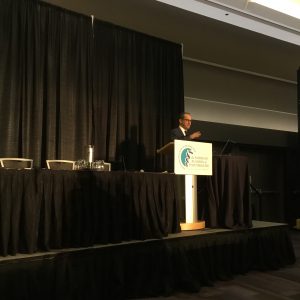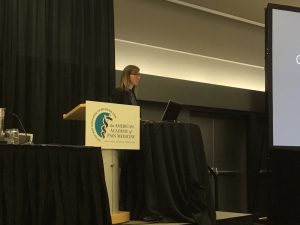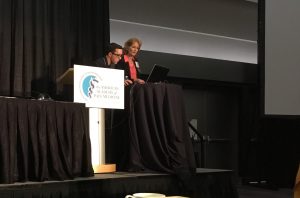Role of Psychology in Interdisciplinary Pain Management
At the 2018 American Academy of Pain Medicine Annual Meeting, Patricia Cole, PhD, from Shirley Ryan AbilityLab discussed the role of psychology in an interdisciplinary pain management program. The initial psychological assessment for an interdisciplinary pain management focuses on whether there are any contra-indications pain management including: Significant cognitive impairment. If the patient has cognitive impairment such as limited short-term memory they are not a good candidate. Making sure their emotional status is stable enough for the pain management program so that they are not a threat to themselves or others. It is important for the patient to be ready
(Read the full article…)
What to Do After Formal Pain Management Treatment
At the 2018 American Academy of Pain Management Annual meeting, a panel discussed how you approach patients after they have completed an interdisciplinary pain management program. The panel included: James Atchison, DO – Shirley Ryan Ability Lab Ravi Prasad, PhD – Stanford University School of Medicine Patricia Cole, PhD – Shirley Ryan Ability Lab Elizabeth Gaffron, MOTR/L – Shirley Ryan AbilityLab Sharon Hsu, PhD – Swedish Medical Center Felix Lavsky, MS – Shirley Ryan Ability Lab Kristin Lucas, PT, DPT – Swedish Medical Group Hannah Nilles, PT, DPT – Shirley Ryan Ability Lab The speakers talked about the importance of
(Read the full article…)
Current State of Interdisciplinary Treatment Programs
At the 2018 American Academy of Pain Medicine Annual Meeting, Michael Harris, PhD, from Pacific Rehabilitation Centers, discussed the current state of Interdisciplinary pain treatment programs. Interdisciplinary Care means a group of different specialties and experts who are involved in patient pain care in an equal fashion, and share a single goal of improving the patient’s quality of life. A typical team includes: Medicine/nursing Psychology Physical Therapy Occupational Therapy Biofeedback relaxation Wide variety of alternative approaches These programs started in the Northwest in the 1960s and they have now spread around the world. The first program was accredited in 1986
(Read the full article…)
Intro to Interdisciplinary Treatment Programs
At the 2018 American Academy of Pain Management Annual Meeting, Stephen Stanos, DO – Swedish Health System and President-American Academy of Pain Medicine talked about why the time is right for interdisciplinary pain treatment programs. The opioid epidemic is getting lots of media attention these days and this has been changing prescribing habits of physicians. How do you approach pain control in this new environment. The time is ripe for interdisciplinary pain management programs. The National Pain Strategy is the government’s first effort into developing better pain management at the primary physician level including self management and interdisciplinary pain programs.
(Read the full article…)
Sleep Away the Pain
At the 2018 American Academy of Pain Medicine Annual Meeting, a panel discussed how the use of cognitive behavioral therapy for insomnia and chronic pain. The speakers included: R. Robert Auger, MD – Mayo Clinic Fiona Barwick, PhD – Psychiatric and Behavioral Sciences Heather Poupore-King, PhD – Stanford Hospitals and Clinics Most treatment for chronic pain focuses on finding the source of the pain and addressing it. However, the psychology of pain is an extremely important aspect of pain management which is often overlooked. Impairment with sleep is a common element with chronic pain as up to 88% of patients
(Read the full article…)
Virtual Reality and Acute and Chronic Pain
At the 2018 American Academy of Pain Medicine Annual Meeting, a panel discussed the use of virtual reality (VR) for acute and chronic pain. The panel included: Kim Bullock, MD – Stanford University Jeffrey Gold, PhD – Keck School of Medicine, USC Ted Jones, PhD – Pain Consultants of East Tennessee There is a shortage of treatment options for pain medicine. It’s very difficult to find physicians that are board certified for pain medicine, pain psychologists are in extremely short supply and it’s also difficult to find occupational and physical therapists that specialist in chronic pain. It also seems that
(Read the full article…)
Brain Imaging and the Treatment of Chronic Pain
At the 2018 American Academy of Pain Medicine Annual Meeting, Sean Mackey, MD PhD, Chief, Pain Medicine Division at Stanford University discussed the use of brain imaging in the treatment of chronic pain. This session discussed brain imaging technologies to study chronic pain, research, use case application, and medicolegal considerations. A key question in the treatment of chronic pain centers around whether or not neuroimaging can be used to predict pain and treatment outcomes. Pain is a product of the brain. There is a clear understanding of the areas of the brain impacted by pain. Brain biomarkers researchers ask, can we turn
(Read the full article…)
Complex Regional Pain Syndrome (CRPS)
At the 2018 American Academy of Pain Management Annual Meeting, a panel discussed approaches to diagnosis and treatment of complex regional pain syndrome (CRPS). The speakers included: R. Norman Harden, MD – Northwestern University, Athens, GA Viviana Tawfik, MD, PhD – Stanford University School of Medicine Complex regional pain syndrome, formerly known as reflex sympathetic dystrophy, is a form of chronic pain affecting the limbs often resulting from minor trauma or surgery. CRPS is a bio psycho social disease. There is a significant psychological component to it. Diagnosis is based on signs of four types: Sensory (pain) Vasomotor (temperature) Sudomotor
(Read the full article…)
The Evolving Health System
At the 2018 American Academy of Pain Medicine Annual Meeting, Amy Compton-Phillips, MD, EVP, Chief Clinical Officer from Providence Health & Services gave a physician executive’s perspective on the evolving healthcare system. The good news about healthcare is that almost everything is getting better around the world. Life expectancy around the globe is increasing as are infant mortality rates. Access to healthcare and clean water is also improving. What is not getting better are obesity rates in the U.S. and death from poisoning including drug overdoses. The bad news is that healthcare costs are increasing, especially in the U.S. In
(Read the full article…)
Developing Collaborative Multidisciplinary Models
At the 2018 American Academy of Pain Management Annual Meeting, Catriona Burist, DPhy, from Oregon Health Sciences University discussed the State of Oregon’s experience in developing collaborate Care multidisciplinary models for Medicaid patients. The goal of the Oregon Opioid Initiative was to reduce deaths, non-fatal overdoses, and harm to residents from prescriptions while expanding non-opioid pain care. Oregon’s Medicaid program uses Coordinated Care Organizations to provide care to the state’s Medicaid population. These CCOs receive fees based on the number of patients covered and those funds are used to cover services. As part of this initiative, they increased coverage for
(Read the full article…)











